Mae La Revisited / Review Intel Core i7-920 Workstation Build

Thank you for your generous contributions. We're slowly collecting enough images to make the mosaics. I realize I'm posting the same paragraph each week, but I assure you we're on top of this project and doing our best to collect enough of the proper type of images to make the best possible set of mosaics. This is proving difficult so please help if you can.
We are still accepting (and pleading for) images of children from SEA. No matter how terrible you think they are, please send them in anyway. These images will be used to complete a set of 3 high quality mosaics which will be sold to benefit the Karen and Burmese Orphans living in the orphanages and refugee camps. The more images the better, I can use all you have. Please take the time to go through your images for anything you think might help. If you missed the "No Place to Call Home" special, you can click on the link and read more about this. Thank you! QandA@Bkkimages.com
Feature Photograph

Canon 1ds Mark II, 70-200mm F2.8 IS, @F8 1/125th ISO 200
The day was absolutely beautiful. Exactly one week ago from the time you're reading this, I was up on the Myanmar border, camera in hand, notebook at the ready, and totally blown away by the beauty of this sweet spot on earth. All my previous visits
were during monsoon season and I'd marvel as the low clouds hung lower than the mountain tops and with the sun blocked from view how the cool and rainy weather felt so different from Bangkok. But not today. Today the skies couldn't be
any bluer, the leaves more green, or the air more fresh. As the cool 28-30C air gently washed over my head and shoulders I was once again reminded how beautiful nature can be.
This man decided to take a nap high on a pile of logs under a great tree. He chose the perfect place, protected from the sun the cool breeze covered him like a blanket as he slept. From my vantage point I employed my 70-200mm F2.8 IS lens at the full
200mm. I was mindful the man could wake and spoil the picture at any moment, so I forced myself to concentrate and make the capture as quickly as I could. I selected the aperture, small enough for a sharp focus of my subject and his foreground,
but still wide enough to gently blur the parts of the background not vital to the composition. Exposure is critical. Too much exposure and the many highlights that dance across this scene will be blown, too little and the shadows which shape the
scene disappear. I figured I might have time for only one exposure before he woke, so no bracketing. Using my experience more than my light meter I made my settings and made the capture. I didn't make another. I knew it was right.
This image isn't significant because it was right, or because it captured a perfect peaceful moment in a beautiful location or made a great exposure. This image is significant because of the contrast I could see with my eyes, but chose to hide from
the viewer with the assistance of my camera. Notice the picture below.

Canon 1ds Mark II, 70-200mm F2.8 IS, @F8 1/60th ISO 100
This man is also enjoying a quiet peaceful moment. Less than 15 meters from the man in the picture above. The contrast? The man sleeping on the logs is a Thai man. Free to do as he will in Thailand. The man reading the book is a Burmese citizen, a Karen.
He lives behind the wire of the Mae La refugee camp and is anything but free. He lives in a large cage.
We have the same sweet spot on earth, the same great weather, two like men, both enjoying their leisure time. The contrast is in their level of freedom. One man is free, the other caged. One is free based on nationality and accident of birth, and the
other is caged based on nationality and the same accident of birth. They could have been born a mere 500 meters apart physically, but the differences in their lives are light years apart. One man is free to live his life in a country that welcomes
him, the other man escaped from a country trying to kill him and now remains in limbo, a prisoner of circumstances. Behind the wire. The contrast is startling. Made more so when you realize the year is 2009.
Mae La Refugee Camp, Revisited

Canon 1ds Mark II, 24-70mm F2.8 , @F8 1/320th ISO 100
I could immediately tell this trip was going to be different. There wasn't a cloud in the sky and on the trip up I was able to see beautiful vistas and viewpoints previously hidden by the low laying clouds before. More, I was able to enjoy the drive
rather than be on super alert status dodging cars sliding in the rain as they come around the corners totally out of control. There is this certain stretch of highway 112 which feels particularly risky.

Canon 1ds Mark II, 70-200mm F2.8 IS, @F8 1/80th ISO 100
The sky was a delightful shade of blue, made more precious to those of us who normally spend our days in Bangkok where a blue sky is a once a year event and grey/brown grunge is the norm. Along the border the air is naturally fresh, filtered and scented
by the many trees. Instead of it taking the usual 2 hours from Mae Sot to reach the Mae La camp, it only took 50 minutes. We were actually surprised when we noticed the first huts and the wire.

Canon 1ds Mark II, 70-200mm F2.8 IS, @F8 1/200th ISO 100
Once you get near the camp you'll see many Karens walking along the roadside, allowed outside the wire by their military keepers to barter and trade and forage for whatever the forest provides. Everyone is friendly and waves as you pass.

Canon 1ds Mark II, 70-200mm F2.8 IS, @F8 1/40th ISO 100
No matter how many times you see the huts which pass for 'homes' you'll still be amazed at their "Robinson Caruso" like construction. Bamboo
makes the frame and supports, and the large leaves the walls and roofs. Every 3-4 months the leaves need to be changed to provide any sort of weather tight integrity at all.

Canon 1ds Mark II, 70-200mm F2.8 IS, @F8 1/40th ISO 100
Looking down from the road you notice the trees and shrubs have grown a lot in the recent sunshine. Last month they were half this height. Now the trees and shrubs work together to provide a sort of privacy or shield from passing eyes.

Canon 1ds Mark II, 70-200mm F2.8 IS, @F8 1/60th ISO 100
Colors are more bright, the air more clear. Compared to just 5-6 weeks ago the difference is astounding. Large tubs are used to launder clothes and then they're hung on lines to dry.

Canon 1ds Mark II, 70-200mm F2.8 IS, @F8 1/250th ISO 100
Some of the rooftops of support and admin buildings are made of tin. In the hot sun they make perfect places to dry natural herbs and roots. You'll see different ingredients and food stuffs drying in this manner as you make your way from one end
of the camp to another.

Canon 1ds Mark II, 70-200mm F2.8 IS, @F8 1/50th ISO 100
As always children are everywhere and they'll watch with keen interest as you go about your business. In many ways they appear like any other children you could find anywhere in the world. But then something reminds you they're not like other
children at all, other children aren't kept in cages without hope for nationality or citizenship, caged their entire lives.

Canon 1ds Mark II, 70-200mm F2.8 IS, @F8 1/6th ISO 100
And then there's the children who are curious, but not quite willing to approach too close. They'll hide and peek out from behind almost anything as they follow your movements. I often wonder exactly what they're thinking as they watch,
what they're hoping for.. and what it would take to provide what they wished.
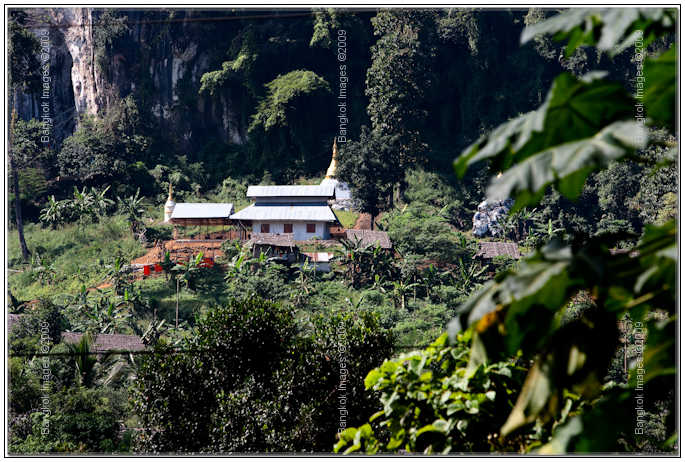
Canon 1ds Mark II, 70-200mm F2.8 IS, @F8 1/200th ISO 200
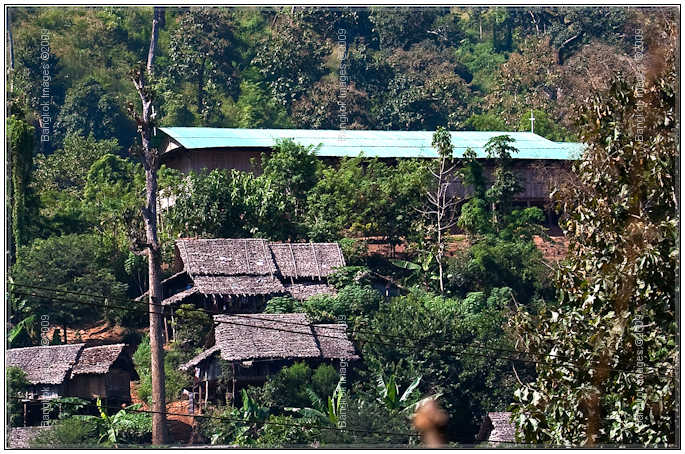
Canon 1ds Mark II, 70-200mm F2.8 IS, @F8 1/125th ISO 200
I've told you before that the vast majority of Karens are of the Christian faith, a fact that surprises many of the Thais experiencing their culture for the first time. If you look carefully along the hillsides you'll not only see several Christian
churches, but a fairly good sized Buddhist temple as well.

Canon 1ds Mark II, 70-200mm F2.8 IS, @F8 1/400th ISO 200
With the clear skies the clouds no longer hide many of the huts along the ridgelines you couldn't see, or easily see, before. You can see much better which reveals the camp is that much bigger than you initially realized. And you never thought the
camp was anything but enormous before.

Canon 1ds Mark II, 70-200mm F2.8 IS, @F8 1/250th ISO 200
No matter where in the camp you might be, you'll still be thrilled to witness the natural beauty all around you. I can't help but wonder how long it will be before someone realizes this land would be ideal for high-end resorts and million dollar
homes. In America we put the native Indians on reservations located in the most inhospitable and poorest lands we could find. Lands no one else wanted. Lands where it was impossible to farm effectively and game was scarce. How long will it be
before..

Canon 1ds Mark II, 70-200mm F2.8 IS, @F8 1/125th ISO 200
Along the roadsides you'll find small groups of refugees with items for trade, waiting for the trucks to come by and barter for their goods. Their patience is incredible. I noticed this group in the same location, with the same bag, waiting for over
six hours.

Canon 1ds Mark II, 24-70mm F2.8 , @F8 1/320th ISO 200
The foliage is so dense, and the light so filtered, that you'll miss much. Small children standing motionless go unnoticed. Without movement your eyes will pass over them without notice.

Canon 1ds Mark II, 24-70mm F2.8, @F8 1/80th ISO 200
Another example. High up on a ridge, without movement, it would have been very easy to miss this small family. I only noticed them after stopping and intentionally scanning the hillsides. The natural backlighting helped them stand out a bit, but it would
have been very easy to miss them altogether. Of course they notice me, and it appears I'm of some interest.

Canon 1ds Mark II, 70-200mm F2.8 IS, @F8 1/250th ISO 200
Against a dirt embankment this small boy looks on with interest.

Canon 1ds Mark II, 70-200mm F2.8 IS, @F8 1/250th ISO 200
This small group of girls watches from approximately 200 meters distant.

Canon 1ds Mark II, 70-200mm F2.8 IS, @F8 1/400th ISO 200
And then others will be all smiles. These two brothers were on their way to a swimming and fishing hole. Their bamboo poles with fixed length lines were carried with pride. I can't help but think brothers all around the world enjoy similar activities
together. I know my brother and I did, as did my sons and I. As a kid I used similar home made fishing equipment.
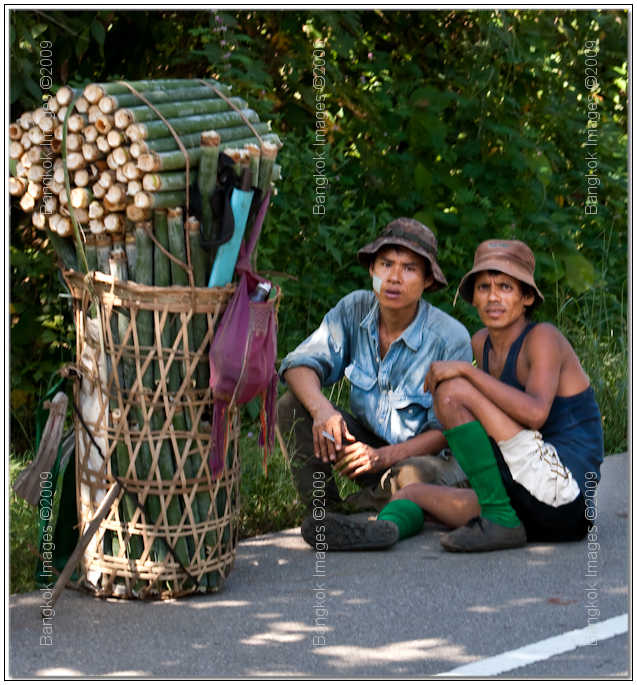
Canon 1ds Mark II, 70-200mm F2.8 IS, @F8 1/125th ISO 200
Another group waiting by the roadside for someone to come along and trade for their products. They've only been there for two hours and seem to be very happy

Canon 1ds Mark II, Sigma 12-24mm F4, @F11 13mm 1/100th ISO 100
As you leave the camp behind and continue along the road you'll notice signs in Thai. Many of them tell you of waterfalls and viewpoints. The forest and trees are so thick you'll often forgot what's really around you. Following a set of
signs up a dirt road for a click or two we suddenly burst from the darker cover of canopies into the sunlight. Looking out from the vantage point you'll see mountain after mountain. The views are truly beautiful.

Canon 1ds Mark II, 70-200mm F2.8 IS, @F8 1/40th ISO 100
Small streams are everywhere. A source for fresh water, cleaning, bathing, and doing laundry. They also provide for recreation for those who wish to fish and swim. Unfortunately they're also the camps sewer.
This area along the Myanmar border out of Mae Sot provides some of the most beautiful land you'll ever see in Thailand. It's almost like being in another world. This is very desirable real estate for those who love living in such clean and beautiful
surroundings. Unfortunately it also houses up to 9 refugee camps holding up to half a million refugees at any one time. Half a million individuals who live in very primitive shelters subsisting on donated anti-starvation diets. No country wants
them. They have nowhere to go. Their entire lives seem destined to be lived out inside these camps.

Canon 1ds Mark II, Sigma 12-24mm F4, @F11 19mm 1/400th ISO 100
Later this same day I made it up to the Safe Haven Orphanage I shared with you last several months ago. I'll share that part of the trip with you next week.
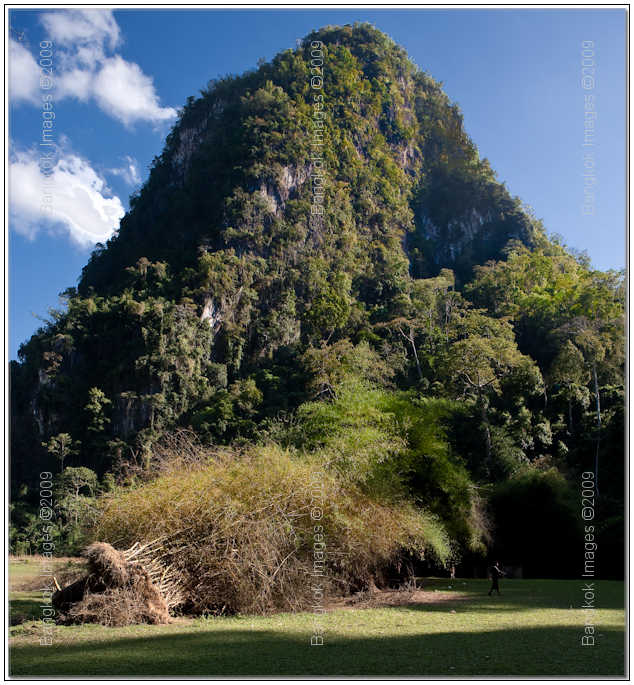
Canon 1ds Mark II, Sigma 12-24mm F4, @F11 24mm 1/125th ISO 200
Review, i7-920 Workstation Build

Purpose
My workstation is probably a bit unique in that I use it for everything. I need a workstation that can download television show torrents in the background, play television or radio shows on the HDTV, manage my email client, maintain an open browser with
up to 10 tabs, run my VOIP services, instant messaging, run my Slingbox, and run ALL my imaging programs which include Adobe's CS4, Lightroom, Phase One's Capture One Pro 5, and more. My workstation must be able to run all these programs,
across two monitors and a 50" HDTV, at the same time without slowing down or bottlenecking. It must also be a fully functioning HTPC (home theater PC) and output my music and video files in
DTS, Digital Dolby, all in 1080p HDTV. I ask and require a lot from my workstation, but I demand 100% reliability.
Another goal of my system was silence. I don't ever want to hear my workstation. No fans, no hard drive noise, no vibration, nothing but silence from 3 feet away. I've achieved this goal despite running (8) high quality liquid bearing 120mm
fans. I power these fans through a smart card controller which maintains their speeds barely above the minimum level which means they're virtually silent.
Because I demand 100% reliability, or as close to it as possible, and for certain it's my first priority, I am willing to purchase the very best components. Keep this in mind as you read through my build. If you're priorities are different you
can probably save some money by buying less expensive and reliable components.
Choosing a CPU
We've never had more excellent choices available and all these choices can be more than a bit confusing. I'm going to be very direct with my choices and reasoning. The Core i7 920 is a four core, 8 thread, cached CPU which has been out on the
market long enough to undergo several revisions and become the darling of the over clocking community. The 920 requires the x58 chipset motherboards which are a bit more expensive than the p55 motherboards required of the newest Core i7-860. The
920 runs at a stock speed of 2.6ghz, and the 860 at 2.8ghz. The differences in clock speed are not significant for imaging purposes.

There are a many choices for CPUs and motherboards and listing them and comparing their advantages could take several pages. I'm not going to do that. Instead, I'll tell you why after reading countless articles, comparisons, and reviews, I've
settled on the Core i7-920.
The Core i7-920 has been out long enough to be 'perfected' with several revisions. The x58 motherboards have 6 memory slots which are easy to fill inexpensively with (6) 2gig sticks of DDR3 Triple
Channel memory for a total of 12gigs. And the very next Intel CPU's coming down the pike are 6 core, 12 thread CPU's which will require a 1366 socket and x58 chipset just like the Core i7-920. This means the motherboard manufacturers
'could' write a firmware upgrade for your existing system and all you'd have to do is update the firmware and change out the CPU to have the most modern system. Will they? I don't know. But they can.
Also, the Core i7-920 has been over clocked with success more than any other chip out there and it has a reputation for being extremely easy to over clock. Normally I wouldn't over clock a imaging workstation, but from countless reviews and articles
I learned that the Core i7-920 could easily and reliably over clock to 3.8ghz with the change of one setting. This makes the Core i7-920 a keen bargain and a screamer in the performance department. Properly cooled a Core i7-920 2.6ghz over clocked
to 3.8ghz is 100% reliable with a very healthy life-span, much longer than the 4-5 years I normally keep a system.
With all this in mind I was convinced the Intel Core i7-920 at $275 was the best choice for my requirements.
CPU Cooler
The Intel Core i7-920 comes with an Intel supplied CPU fan. It's adequate, but it's also noisy. If you want a silent machine, and you want the best cooling possible, then you'll need to run an after market CPU cooler. One cooler stands
out as the industry favorite both for build quality and performance. The Thermalright 120mm Extreme. In every test,
every review, it comes out at or near the top. Installation is easy and all the hardware is top quality. This is the cooler to get. $45


Motherboard
There are more x58 chipset motherboard choices out there than there are CPU choices. So how do you know which one? During all the reading and research I noticed the guys who really knew what they were talking about tended to gravitate towards certain
boards. Sometimes because they were a great bargain, sometimes because they were a great performer, and sometimes because they were a rare combination of both. The Asus P6T Deluxe Version 2 Motherboard was one of those that consistently rose to
the top of any discussion when seeking the best overall motherboard.
The AsusP6T Deluxe Version 2 has also had the luxury of several revisions and refinements and has a reputation for being top quality in every respect and even more reliable.
Further, its firmware BIOS allowed a rock solid 3.8ghz over clock of the Core i7-920 by changing only a single setting. This seemed the most solid choice at about $250.

Memory
What kind, what speed, and how much memory are the questions. More, has this particular memory been tested and certified by your motherboard manufacturer? I started reading. I didn't stop reading for weeks. There is that much to know about memory.
Finally, I found a very in-depth and easy to read report where they asked the question "at what point of memory speed/quality will you not realize more value for more money spent?" Perfect! They tested almost every available memory type
out there and they just so happened to be using the same CPU and motherboard I was interested in. It seems my CPU and motherboard are commonly used by major system builders.
I'll summarize this. With the current front bus speeds, CPUs, and memory speeds vs. price.. there is no significant advantage where it comes to performance past the 1333mhz speed. Asus certified Kingston 2gig modules, purchased in 6gig kits of 3
modules each, of this speed and model number. They were certified as being tested by my motherboard manufacturer, they only cost $192 for each 6gig kit, testing revealed there was no significant advantage
to going with a higher speed, and they were guaranteed for life. Perfect!

Video Boards
I'm not going to go much into video cards. I'm using two XFX Nvidia 7950GT's. I'm using two cards because I want to use two profiled monitors, and even though each card has two video outputs only one of those outputs on each card had
it's own LUT (look up table). Altogether I'm running 3 monitors if you include the HDTV, but my HDTV isn't required to have a color profile, only my imaging monitors.
Any video card with a minimum of 512mb of memory, a suitable output for your monitor, and the OpenGL standard (so they play nice with CS4's video hardware acceleration), will be suitable for image processing. You don't need the fastest gaming
cards. You also don't need the slowest. I would say almost any Nvidia card in the 7000, 8000, 9000 or the new 200 series will max out performance for image monitoring. And the same with the ATI equivalent. This is not the place to waste money,
but a very easy place to spend money unnecessarily.
Also know the more powerful the GPU (video card) the more power it requires, the more heat it makes, and the more noise the fans make trying to cool them. Lesser power cards which still max out your needs for image processing will require less power,
run cooler, and make less noise. My XFX 7950GT's were my choice because they didn't have onboard fans. Instead they have big passive heat sinks. These keep them cool with no noise. None. These cards can be found for about
$60 each.
Optical Drives
Buy what you need but don't overspend. Do you need Blue-Ray? If not don't get it. $30 will get you a quality SATA II interfaced CD/DVD burner.
System Drives

System drives hold ONLY your operating system and your programs. They don't need to be large, but they benefit greatly from being fast.
I'm currently using a Western Digital 300gb Raptor II SATA II drive. 3 years ago this was the fastest system drive available. Soon I'll replace it. With what? When the SSD market bottoms out, which will be very soon, and they offer at least
a 256gb SSD (solid state drive) with 200mbps+ transfer speeds for under $300.. then I'll get one. I might get two and put one in my laptop.
Currently SSD's are not as reliable as I'd like them to be. The speed is certainly there, but they're still working out mystery phantom data losses and other issues with the controllers and firmware and for something as important as a system
drive I'd want more refinement and even more reliability.
IF I had to replace my system drive today I'd be torn between three types of drives. Another Raptor exactly like what I have, an Intel x25 SSD (the 256gb model is currently about $500), and one of the
new SATA II 6gps terabyte drives which are even faster than the Raptor. You WILL notice even a bit of speed increase in a system drive. If you're interested in performance this is where you should spend some money.
Storage Drives
Good
So many possibilities. SATA II 1tb (terabyte) drives are available for as little as $89. Heck, I just picked up two 2tb SATA II drives for $149 each. 3-4 of these would be all most photographers need. This will be the route most should take.
Remember, a standard motherboard will have a minimum of 4 and a maximum of 8 SATA II ports. With your system drive using one port, your optical drive using another, this leaves from 2-6 open ports. Choose your motherboard to fit your storage needs.

Better
But what if you want something faster and more reliable? Look at the new SATA II 6gbps hard drives. The 2tb models are roughly $350-$400, but they're very fast for mechanical hard drives and they're very reliable server class drives which should
run for years without a single error.

Even Better
Forget about the RAID controllers embedded on the motherboards. There are two reasons to use RAID setups. Speed and/or data redundancy. RAID 5 is perhaps the most common RAID mode used for storage drives, but do look into RAID 6 and RAID 50/60 for larger
RAID arrays.
RAID cards come with ports for 4-12 hard drives and more. The most common would be 4 and 8 ports. My Promise Technologies EX8650 controller will run both SATA and
the faster more expensive server class SAS drives. I won't cover SAS drives except to say if you're loaded with money and want the very best performance do some research into SAS drives. So far I've used 500gb and 1tb drives with
this card in both RAID 5/6 and 50/60 configurations.
The EX8650 like most other quality RAID cards has it's own processor and memory for maximum performance. These require a PCI-e slot so choose your motherboard accordingly.

I chose to not build a RAID array into my newest workstation. Why? Because with the availability of 2tb internal drives and 6 SATA II ports on my motherboard, I can have quite a lot of storage in my case without RAID. AND I'll be setting up a RAID
in my independent server machine in the near future and writing a review on how to build and manage a Windows Server.
When I do choose the drives for the RAID in my new server I'm fairly certain I'll be using (8) 2tb SATA II 6gbps server class drives. These will be expensive, but cheap overall per megabyte. With 8 drives I'll run a RAID 60 which means
I'll have 12 terabytes of actual storage, and two drives redundant. This means I can lose two drives and still not lose a single bite of data. Three drives would have to fail at the same time to bring down this setup. Short of an electrical
surge or a flood this won't happen.
Best
You've guessed it. If I had unlimited funds and wanted the most secure and best performing storage I'd use a RAID controller with SSD drives. You can currently buy 1tb SSD's. 8 of them will set you back about as much as a new economy sedan.
It's possible and available today.. but it will cost you.
Power Supply
The power supply is the single most critical component in your system. The power supply supplies 'conditioned' and 'precise' power to every component.
This is not where you save money. Power supplies can also generate a lot of heat and noise, so choose your power supply according to your system needs.
There is only one power supply I will personally use and I have several of them. PC Power and Cooling makes the absolute best and most reliable power supplies available. There are other good ones,
and a few really good ones, but there's only one made to the specifications and detail at this level.
In my server I run a Turbo-cool 1200w. It's a noisy monster of a power supply suitable for server use. However, in my workstation where I don't have the same power requirements I'm using a Silencer 910 . This is a very quiet power supply which fits my goal of a silent machine.

Whichever power supply you select make sure it has the right type and number of power connectors for the system you're building.
The Case
Many PC users were in awe of Apple's Power Mac which sported a case which an only be described as a work of art. Most PC users aren't aware that Lian Li out of Taiwan makes equally
beautiful and functional cases. If you want the Cadillac of computer cases then Lian Li cases should be on your short list. Nothing else compares.
Tool-less access, aluminum construction, and artistic design set Lian Li cases apart as the very best. They come in many styles for several needs so check them all out carefully, read a few reviews, and choose the right Lian Li case for your needs.
I'm still using my 7 year old Lian Li case because frankly I see no need to change it. If you purchase quality components your subsequent upgrades will likely be limited to a new CPU/Motherboard/Memory upgrade. Your case, power supply, and storage
drives will transcend builds.

Some things to remember about cases. The more power your components will require, the more heat they'll generate. Well designed air flow, large quiet fans, and even large cases will help dissipate heat effectively. Cases are also limited to how many
drives of each type they will hold. Check your specification build list against each case you're considering.
When I build my server next month I'll buy a new Lian Li case. It will probably be a mid-size case and I'll put my workstation components in this case, and use my old full tower case for the server. The one thing I know for sure is that it will
be a Lian Li case. No shoddy workmanship, everything fits, no sharp edges to cut my fingers, and once everything is together it will have proper airflow and keep things running cool. They look awesome too.
Input Devices
Input devices are personal, but very important. There are a slew of such devices out there and often you'll need to spend a considerable amount of time checking them out to find the ones which fit your needs the best. The three input devices I use
are the Logitech Performance Mouse , the Logitech Di Novo Edge Keyboard,
and the Wacom Intuos 4 graphics tablet.
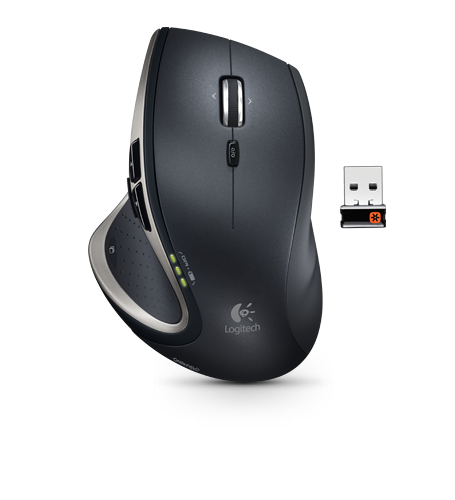
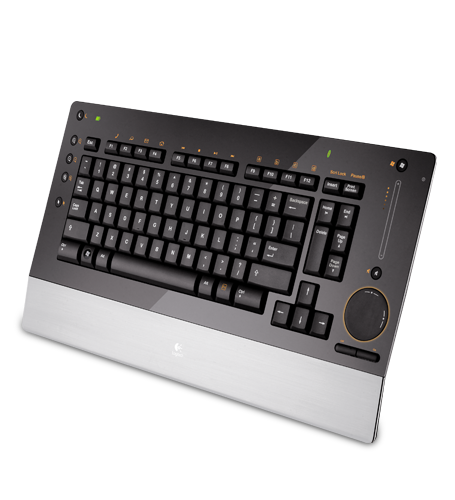
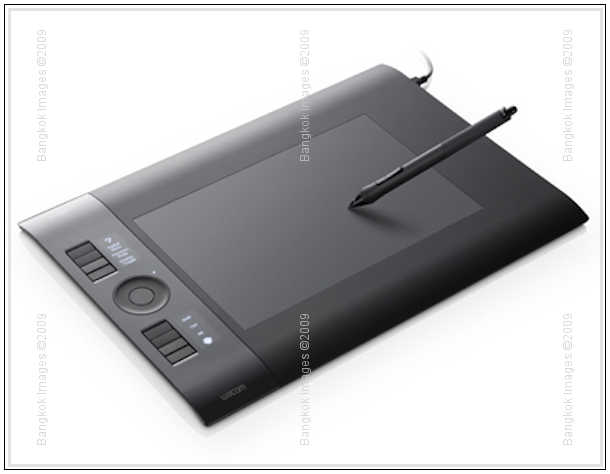
Input devices are what you use every single time you use your workstation. This isn't an area to skimp. You'll be rewarded many times over for purchasing the best input devices you can afford.
Monitors
We always end up here and there are many choices in as many price ranges. I'm only going to tell you that I use (2) 21.5" LCD panels in a dual display stand and a 50" HDTV for my video needs.
Below is a list of VERY GENERAL recommendations when looking for a monitor.
- Buy a minimum of 20 inches
- Two monitors are known to be much more productive than one
- S-IPS LCD panels are recommended for imaging
- Monitors come on all qualities from very cheap, to very expensive. Buy what you need
- Monitors will need to be profiled for correct color. A profiling device will be required
- Pay attention to the warranties. Especially with expensive monitors
- Image monitors should ALWAYS have a matte surface. Glossy monitors are a handicap
Over Clocking
I'll say right out that I sincerely don't believe over clocking and image workstations go together. Oil and water. I recommend against it 99.9% of the time. It's not worth risking the integrity of your images/data. The speed increases aren't
worth it.
I'm over clocking. What! Please allow me to explain before lynching me for being an hypocrite. During the course of my reading and research, and please know that I read the trade magazines and journals on a daily basis and have for years, one combination
of processor and motherboard stood out as absolutely reliable for over clocking. I decided to give it a try before processing images. I made the one setting change in the BIOS and as advertised I was instantly running at 3.8ghz.
Confession time: I forgot I was over clocking. Two months of testing, using, and installing programs went by before I remembered I was over clocking. Not once during this time, or the subsequent two months of use before writing this review, did I ever
have a single error related to over clocking. Not a single blue screen of death, no required reboots, no software errors, and my CPU temperature never exceeded 52c and it was only that high when really pushing the CPU at maximum for long periods
of time. Idle temp is a steady 38c, and an honest average temp when working large amounts of data is 44c.
Performance
Initially I was going to run the same tests Craig Lamson did in his laptop review last week. After running just a few of these benchmarks I realized these systems are, not only not, in the same league, they're not even in the same universe. A workstation
built to these specifications will be faster than you can imagine, and faster than you'll probably need. As always, when you do have to wait on something it will be the drives as you pull data on/off the storage media. Otherwise even previously
long tasks just 'flash' done.
What really counts with performance is how much time it takes you to complete your workload. This same system with my previous motherboard (Intel 975xbx), CPU (Intel Core 2 Duo 2.67g) and memory (4gigs of DDR2), compared to my upgraded system shows a huge performance gain. Let me give you some examples:
- My standard workflow is to process my images in Lightroom and create a collection with up to several hundred 'semi-finished' images which I'll then import into CS4 Photoshop for final processing. Because this final processing
can take some time I'm also using my PC to play a movie on the HDTV, listen to music, or maybe watch a cable channel vs. my Slingbox. My browser with up to 10 tabs, Yahoo messenger, torrent client, and my email client is ALWAYS running
in the background. With Lightroom open I could import 3-5 images into CS4 Photoshop as 16 bit 98mb tiff files. I could then finalize these images and save them, and then bring in 3-5 more. Standard tasks would be levels adjustment, saturation,
Focus Magic, and a noise reduction plug-in such as Neat Image. Each image would take roughly 5-8 minutes. ALWAYS when initially opening these images into CS4 Photoshop the movie playing would freeze. Everything else like the browser would
be unusable. Once loaded things would be better. With the new system I can open as many images into CS4 Photoshop as I want, for instance last night I loaded 48 16bit 98mb images at one time into CS4. The system doesn't even sneeze.
Everything not only works without momentary freezes, but it works just like it always does. For grins I opened 100 16 bit 98mb tiff images and got the same result. Instead of needing 5-8 minutes per image, I now need less than 30 seconds.
It completes its tasks literally as fast as I can press the mouse button.
- Video rendering. I've been working with Adobe Captivate learning how to make Flash based tutorials, a feature I plan to offer in this column soon. My old system would take hours to render a 10 minute tutorial. The new system does the
same in less than a minute. And it does it without slowing down anything else running at the same time.
- I have a "CPU Usage" indicator that shows a colored bar for each thread. When idle these bars reflect no usage. During light work one or maybe two threads are being taxed. No matter how hard
I try to tax the performance of this machine the best I can do is to get 4-6 of the 8 threads working, and then only from 10-50%. There is always a great amount of processing power in reserve.
- I want to make clear my system isn't "lean" or set up to run the bare minimum to increase speed. I have everything activated and installed. And I'm always running video/music, and
my other programs in the background.
I get a lot of questions that ask "how much memory do I really need?" The answer to this is easy, you need at least the minimum amount of memory listed under requirements for your program or operating
system. Usually this will be 1-2gigs. However, the best way to improve the performance of any computer is to increase the amount of RAM. How much? I'd say for most uses 6gigs will make you very happy and provide a great level of performance.
If you're like me and do a lot of things at the same time and you don't want any slow downs no matter how many tasks you have open and/or running, then 12gigs would be better. 12gigs of quality fast Triple Channel RAM DDR3 memory is currently less than $400. It's a bargain.
Operating System
Windows Vista x64 Ultimate
This machine is set up to use Windows Vista Ultimate x64 Service Pack 2. Any machine with over 3gigs of memory will need to run a x64 bit operating system. I was an early adopter of Vista and besides for a few bugs here and there, and a few old pieces
of hardware which weren't supported, I didn't have nearly the issues you'd read about. If you listened to the naysayers Windows Vista was the devils work, and was not only buggy but would also crash your system and steal little
children in the process. My personal experience running Vista x32 and x64 across 2 workstations and 5 laptops.. is that Vista was a pleasure to use in all of them. More, especially in the x64 machine, Vista made my machines run smoother and more
reliable. I never turn my workstation off. The only time I need to reboot the machine is once per month after it automatically downloads and installs the latest updates from Microsoft.
XP Professional would allow certain programs to work faster, especially moving data across my home network between other PC's and my NAS servers. However, Vista was far superior for my imaging programs, or any program which used a lot of RAM. I'm
convinced the Vista memory manager was responsible for this increase in performance. For instance, with XP Pro I'd often have to exit Photoshop after processing so many images, and then bring it back up again and continue. Performance would
drop off until I did this. With Vista I could run the same Photoshop for weeks and thousands of images without needing to do this.
I've ran this upgraded system on Windows Vista x64 Ultimate for almost four months now. There have been NO blue screens of death, no crashes, and no issues which couldn't be attributed to application software.
Windows 7 x64 Ultimate
I hope you believe my experiences with Vista, because Windows 7 uses the Vista core and is essentially the same operating system with a slick new UI. Sitting before me is a brand new System Builders OEM copy of Windows 7 x64 Ultimate. I've had it
for a while now, staring at me, taunting me, daring me to mess up my perfect performing Vista build by installing Windows 7.
I have two options. I can do a "in place" upgrade from Vista x64 Ultimate to Win 7 x64 Ultimate. This means I can upgrade and it will transfer all my files and programs over including my setup
information. I won't need to reinstall anything. OR, I can do a complete clean install.
Among professionals conventional wisdom for upgrading has been to bite the bullet and do the work for a complete clean install. In place upgrades always resulted in issues that took more time to deal with, than the extra time to do the complete install.
However, initial reports show that Microsoft has improved and fine tuned the 'in place' install to such a degree that now there's very little if any advantage to doing a clean install.
I'll admit to being very curious if this is true.
Upgrade routes you can do, and still do an "in place" upgrade:
- Windows Vista x64 to Windows 7 x64, version to version copy. i.e. Ultimate to Ultimate, Home Premium to Home Premium, etc, etc
- Window 7 version to an upgraded Windows 7 version upgrade. You can upgrade for instance from Home Premium to Ultimate
Upgrade routes you cannot do, with a "in place" upgrade. These routes require a clean install:
- Windows XP to Windows 7
- x32 to x64
Windows 7 x64 Ultimate and I have been in a staring match for weeks now, wondering who will blink first. I can't take it anymore. I'm giving in. Once this column is penned and sent off to Stickman HQ I'll attempt an "in place" upgrade and see how it goes. If necessary I'll do a clean install. Next week I'll be able to share with you what I learned from this process, provided I still have a working computer.
Conclusion
This is a huge area to cover. This is why I limited what areas I covered and what items I talked about. It would be easy to write a book length guide to building your own PC and hundreds have done so. The purpose of this review is to share with you what
I built, what I use it for, and why I chose certain components over others. Hopefully, in the event your requirements are similar then the huge task of researching this subject won't need to be repeated by you. You can just order the same
stuff I did, put it together, and it will work.
Do keep in mind that changing any item may result in parts that physically or electronically no longer fit or work together. If you change anything ask your retailer to be sure they do.
I've already mentioned that if you put together a quality system with quality components, then the next time you need to upgrade to the latest CPU, all you'll need to upgrade is the CPU, motherboard, and RAM. Everything else will translate over.
This means the initial cost of your PC might be high, but over 3-4 upgrades it becomes ridiculously inexpensive. For instance, my last upgrade only required the CPU/Motherboard/Memory and the total cost was somewhere around $700. That's cheaper
than the laptop reviewed in last weeks column!
Good luck building your system. Take it slow and ask if you're not sure, and it's not that hard to do. There are tons of "building your own PC" resources available on the web.. there
are even Utube "how to" videos.
I hope this helps..
Photography News of Interest
Canon's new EF 100mm F2.8 L IS USM Macro lens is turning out to be a real winner. Their new "hybrid IS" system makes
the macro lens more useful in areas other than macro photography while maintaining the same superb optics Canon users have come to expect. Check out Digital Photography's Review here.
Change your unit! Hmm.. Okay, really. Ricoh's new GXR 4/3's Micro camera introduces a novel alternative to interchangeable
lenses. How about an interchangeable "unit" comprised of a lens, sensor, and the processing engine (supporting CPU and electronics)? Each time you change the lens you'll also be changing the sensor and cameras CPU. The 'Body"
essentially holds the battery, the LCD review screen, and the knobs and buttons. I'll admit to thinking "what the heck are they thinking?" There's a lot of discussion about the GXR out there this week. Read a preview of the GXRhere.
The Nikon D300 set new standards for a prosumer DSLR, redefining what we should expect from a DSLR in this price range. Recently Canon announced and brought to market their new 7d which
directly competes with the D300. In response Nikon upgraded the D300 to the D300s which basically just adds video capability. Read the reviewhere.
Zeiss is upgrading eight of their F-Mount (for Nikon) lenses to include a working electronic interface which fully supports automatic modes and transfers Exfil data. This is big news for
Nikon owners as Zeiss makes superb lenses. They're upgrading their 18/3.5, 21/2.8, 35/2, 50/1.4, 50/2, 85/1.4, and the Distagon T 28/2 and macro Planar T 100/2.
Read more about what automatic control has been added to these eight lenses here.
How many Bibble users out there? I've been a licensed Bibble user for years, but I'll admit I only use it for the occasional image as I find other raw processors meet my workflow
and image quality requirements better. Still, it's interesting to note that Bibble released a public beta version of their new Bibble 5. You can get a free copy of this beta version
and a beta license here.
Readers Submissions
Hi Steve,
It’s been a while since I’ve submitted something, so here’s a few more pics for your weekly. The evening images were taken during one of those Chao Praya dinner cruises. All handheld at 1600 ISO, so the sharpness/detail does leave
to be desired.
The last 2 of the cat were just taken for fun when I was trying out my shiny new Sigma 12-24mm. She happened to cross my path and was keen on having her picture taken!
Rgds,
KVW








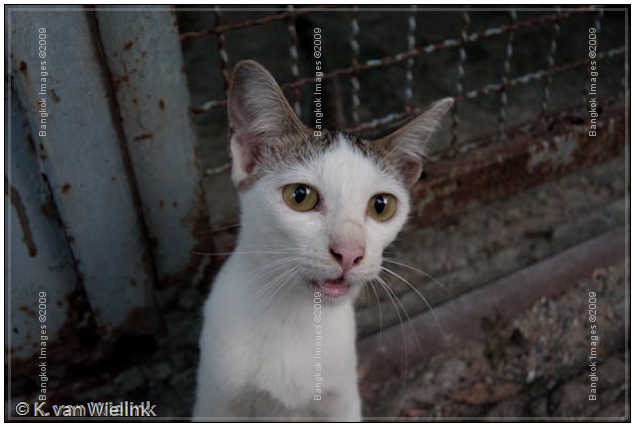
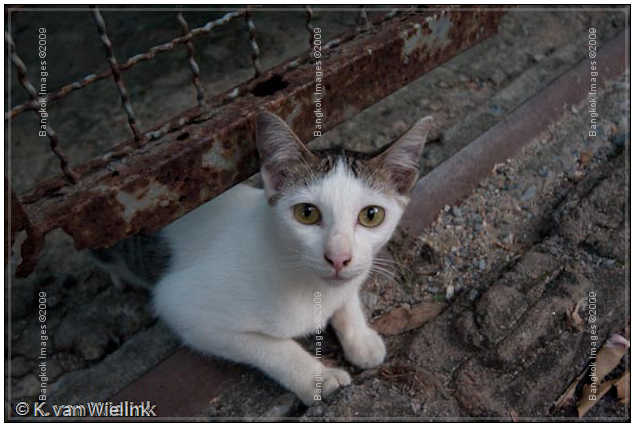
KVW –
Thanks for the submissions. These images are nice and show you're thinking a lot more about how to get meaningful images in conditions you haven't previously considered. In the night shots you were careful to not clip any highlights and you
tried to expose as much of the shadow areas as you could. Each shot takes advantage of an artificial light source. And it's obvious your bracing technique is really improving as I look at the exfil data. Great progress!
Steve
I suspect the readers submissions will be a highly anticipated section of this column and I encourage anyone with photographs and travel accounts they'd like to share to please send them to me at: QandA@Bkkimages.com
Readers Questions
BKKSteve –
What do you know, how do you feel about the Canon G11. I am here in Thailand for the balance of the year using the Sony dsc t90 for fun pictures. Ok pictures with the Sony but the G11 looks better for a "pocket camera".
I see prices here from $500 to 700 USD.
In California, big box store, Best Buy about the same.
Will the G11 give me more bang for the buck than the Sony.
I use Paint Shop Pro for picture adjustments. My Sony Laptop does a good job with handling the PSP software here.
Thanks, enjoy reading your weekly articles.
Rick
Rick –
I'm happy you're enjoying the column.
To answer your question:
I very much approve of the G11. I own a G9 and love it. I think if you need the features it offers which make it a bit bigger than other pocket cameras then it's a fine camera. Those features would be the hot shoe for external flash, dials for settings,
and a bigger size to hold on to.
HOWEVER.. we now have an interesting alternative which I'll probably pick up myself. Canon has announced the new S90 and it's already in the stores in the states and most of Europe so I expect it in Bangkok very soon.
The Canon S90 has the exact same sensor and other electronics as the G11, but in a MUCH smaller package. You get the same speed, image quality, and even raw files. You don't get the hot shoe, but most pocket cams don't have them anyway. You
also don't get the small optical viewfinder.
However, you gain control rings (around the lens) which can be designated for any camera function which makes it very fast handing and you won't need the LCD to search for your favorite functions. You
can just turn the control rings. You're also gaining a lens which is a full stop faster (F2 vs. F2.8) which will make a big difference if you like to shoot without flash in low light areas.
The S90 is truly a pocket camera. And it retails for $100 less than the G11. So, if you don't need the hot shoe, and you don't need the extra heft, and you don't need the accessory lenses (wide, telephoto) available for the G11, then the
S90 offers several advantages with its control rings, smaller size, and faster lens. Image quality, speed, autofocus, it all remains the same between both models.
Let me know which one you end up with and please send in some samples to share with the readers. I'm very curious how you like your new camera.
Take care
Steve
BKKSteve –
Thanks much for the info, I will look for the S90. Sounds even better than the G11 for my purposes.
I loved your autumn pictures from Oregon. I live in Walnut Creek calif. About 30 miles north east of SFO.
Daughter has home at lake Tahoe and great autumn pictures there also.
My Thai wife who is a US citizen and I met in Walnut Creek enjoys fun photography also.
A few pictures from last week using the T90.
Enjoy.
RICK
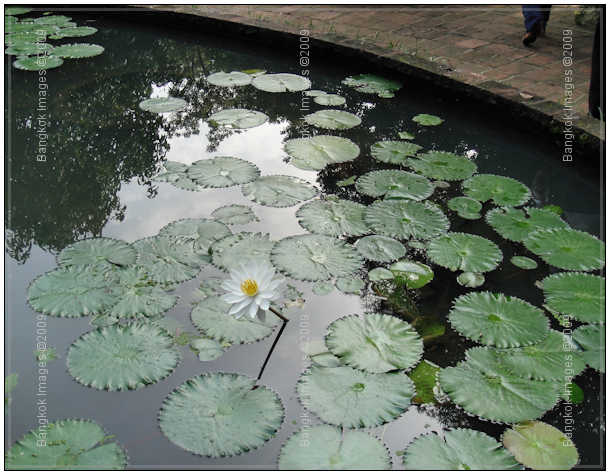
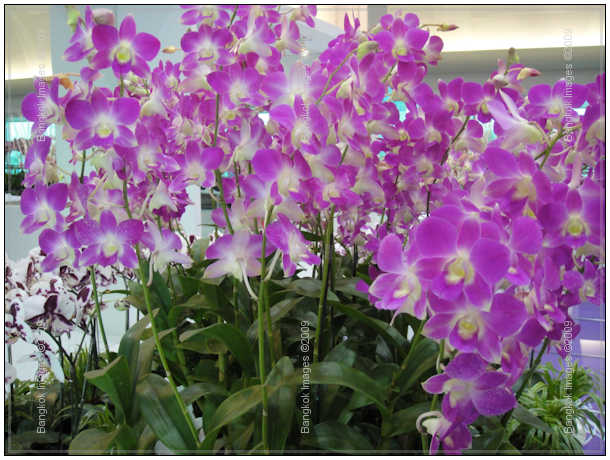
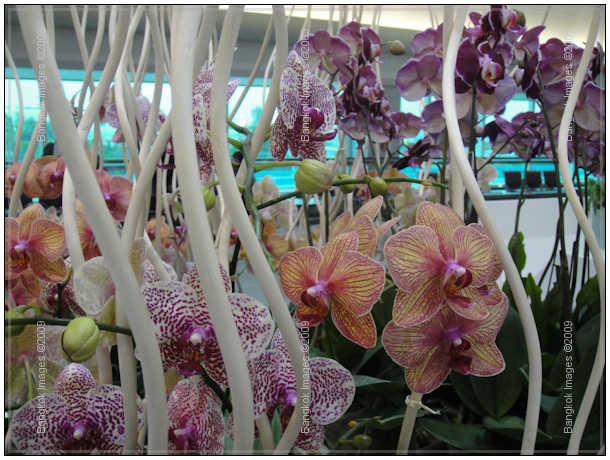
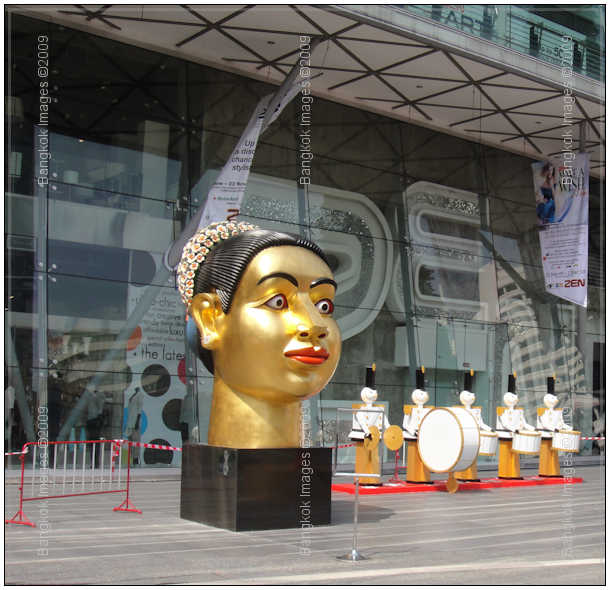
Rick –
Nice! I can't wait to see some images from your new Canon S90. Let us know how you like it.
Steve
Please submit your questions to QandA@Bkkimages.com All questions will be answered and most will show up in the weekly column.
A Snapshot of Bangkok Images Week in Review
I didn't get much accomplished, but I sure succeeded in keeping myself busy. After several false starts I finally was on my way back up to Mae Sot and the Myanmar border and refugee camps. I spent several days there, met up with some others, and
really enjoyed the change of weather. In my previous visits the rains and cloudy skies gave no hint to the bright blue skies and perfect weather soon to follow.
I hope to have some new galleries up in the coming week, and I hope to have switched my main workstation over from Windows Vista x64 Ultimate to Windows 7 x64 Ultimate. I'll let you know how that goes.
Infocus Blog
Averting Near Disaster of the Data Kind
Like everyone else I often can't wait to get back to my hotel room and pop my memory cards into the laptop and view the days shooting. I'd just spent a long day along the Burma border photographing parts of the Mae La refugee camp and some other
places in the area. I took a shower and cleaned up, made myself a soda, and sat down to import the days images.
I carry inexpensive portable memory card readers which typically cost 200-300 baht at almost any electronics store in Thailand. I placed my 16gig SanDisk Extreme III CF card in the reader, plugged the reader into the USB port, and was ready to import
my images. This is when I discovered I could not see my CF card in Windows Explorer! I connected and reconnected the card reader several times with no change. Curious, I pulled the CF card from the reader and looking down into the socket I noticed
two bent pins!
I had no way to fix the pins in the field so I decided to put the CF card back in the camera body and download directly. When I put the CF card back in the body the camera wouldn't read the CF card! This wasn't good, I had over 700 images from
the days shoot on that card. In any event I couldn't do anymore with it until I returned home and had different card readers and recovery software available. I put a fresh CF card in the camera and went on with my trip.
A few days later I arrive home and one of the first things I want to do is to recover my images from this card. I put the card into a quality card reader on my main workstation and I get an error message letting me know my card was corrupted and the data
couldn't be retrieved. This wasn't looking good at all. It appears that not having those two bent pins in the card when I originally inserted it in the other card reader, resulted in corrupting the card. I didn't know this could
happen so easily.
I Googled the problem and contacted SanDisk's support division. No remedies on Google and SanDisk only offered to replace my card. They said there was nothing they could do to recover my images.
Now, with nothing to lose I used a utility to "repair" the MBR of the card. With the MBR repaired several recovery utilities indicated they could now start the recovery process. I used two. SanDisk's "Rescue Pro" appeared to work,
but read all my RAW files as TIFF files. The tiff files could be read as raw files but I wasn't sure if this would cause a problem in the future, so I tried Photo Rescue Advanced and 12 hours later it had recovered my files in the raw format.
They no longer had the original file names but that was okay, the files were there.
I learned several lessons from this:
- Be very careful when inserting CF cards into the cheaper card readers so you don't bend pins
- Consider only using quality card readers
- Consider installing recovery software on my laptop
- Don't give up just because the card company says they can't help you. Keep trying, keep asking questions, you'll find someone out there who has had the same problem and might be able to offer some useful advice
- Recovery software takes a lot of time for a 16gig card, upwards of 12 hours
- Recovery software is not created equal. Some works better than others
- Always carry extra memory cards in the event of a failure
- Be patient. Be very patient. Attack the problem from one angle, and then the other. If that doesn't work do some more research, ask questions, and keep working at it. You'll often be rewarded
A satisfactory if not happy ending. It could have been worse. As always I discovered I could be doing things better and more secure. As always I had no one to blame but myself.
Until next time…



